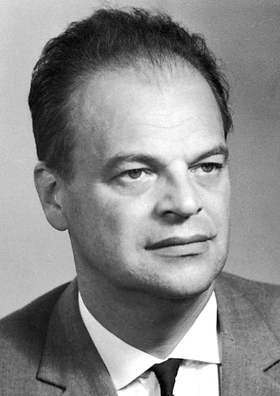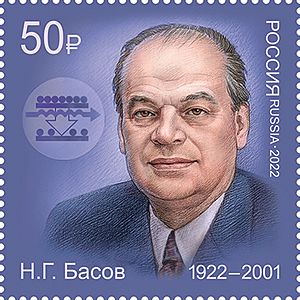Nikolay Basov facts for kids
Quick facts for kids
Nikolay Basov
|
|
|---|---|

Basov in 1964
|
|
| Born |
Nikolay Gennadiyevich Basov
14 December 1922 Usman, Tambov Governorate, Russian SFSR
|
| Died | 1 July 2001 (aged 78) |
| Resting place | Novodevichy Cemetery, Moscow |
| Alma mater | Moscow Engineering Physics Institute |
| Known for | Invention of lasers and masers |
| Awards | Nobel Prize in Physics (1964) Kalinga Prize (1986) Lomonosov Gold Medal (1989) Edward Teller Award1991) |
| Scientific career | |
| Fields | Physics |
| Institutions | Lebedev Physical Institute |
Nikolay Gennadiyevich Basov (Russian: Никола́й Генна́диевич Ба́сов; December 14, 1922 – July 1, 2001) was an important Soviet physicist and teacher. He is famous for his groundbreaking work in a field called quantum electronics. This work led to the creation of the laser and the maser. For these amazing inventions, Basov shared the 1964 Nobel Prize in Physics with Alexander Prokhorov and Charles Hard Townes.
Contents
Nikolay Basov's Early Life
Nikolay Basov was born in the town of Usman in 1922. This town is now part of the Lipetsk Oblast in Russia. He finished school in 1941 in Voronezh.
Soon after school, he joined the military. He served in the Red Army during World War II. He was part of the 1st Ukrainian Front and helped in the war efforts.
Becoming a Scientist
Basov graduated from the Moscow Engineering Physics Institute (MEPhI) in 1950. After that, he became a professor at MEPhI. He also worked at the Lebedev Physical Institute (LPI).
At LPI, he earned his advanced degrees. He completed his first big research paper (like a PhD) in 1953. Then, he finished an even higher degree in 1956. From 1973 to 1988, Basov was the Director of the LPI.
He became a member of the USSR Academy of Sciences in 1962. This is a very important group of scientists. He was made a full member in 1966. He also led a special lab at LPI until he passed away in 2001. This lab focused on quantum radiophysics.
Inventing Lasers and Masers
In the early 1950s, Basov and his colleague Alexander Prokhorov did some very important work. They figured out how to build a "molecular oscillator." This device was based on ammonia. Later, this invention became known as the maser. A maser is like a laser, but it works with microwaves instead of light.
They also found a way to make atoms ready to produce light or microwaves. This method is called "population inversion." Their discoveries were first shared in 1952 and published in 1954.
After the maser, Basov started working on the laser. A laser is a device that produces a very strong, focused beam of light. In 1955, he designed a special type of laser called a "three-level laser." Then, in 1959, he suggested building a semiconductor laser. He and his team successfully built one in 1963.
Basov's work on lasers and masers was so important that it earned him the Nobel Prize in 1964. These inventions also led to new ways to defend against missiles.
Involvement in Politics
Nikolay Basov also took part in politics. He became a member of parliament in 1974. This was in the Soviet of the Union, which was part of the Supreme Soviet of the Soviet Union.
In 1983, after the U.S. President Ronald Reagan talked about a plan called the Strategic Defense Initiative (SDI), Basov and other Soviet scientists signed a letter. This letter was against the SDI plan and was published in the New York Times. In 1985, Basov stated that the Soviet Union could also develop similar defense technologies.
Awards and Honours
Nikolay Basov received many awards for his scientific achievements:
- Lenin Prize (1959)
- Nobel Prize in Physics (1964)
- Hero of Socialist Labour — twice (1969, 1982)
- Gold Medal of the Czechoslovak Academy of Sciences (1975)
- A. Volta Gold Medal (1977)
- Kalinga Prize (1986)
- USSR State Prize (1989)
- Lomonosov Grand Gold Medal, Moscow State University (1990)
- Order of Lenin – five times
- Order of Merit for the Fatherland, 2nd class
- Order of the Patriotic War, 2nd class
See also
 In Spanish: Nikolái Basov para niños
In Spanish: Nikolái Basov para niños
- Excimer laser
- Maser
- Alexander Prokhorov
- Lebedev Institute of Physics
- Michelson interferometer



